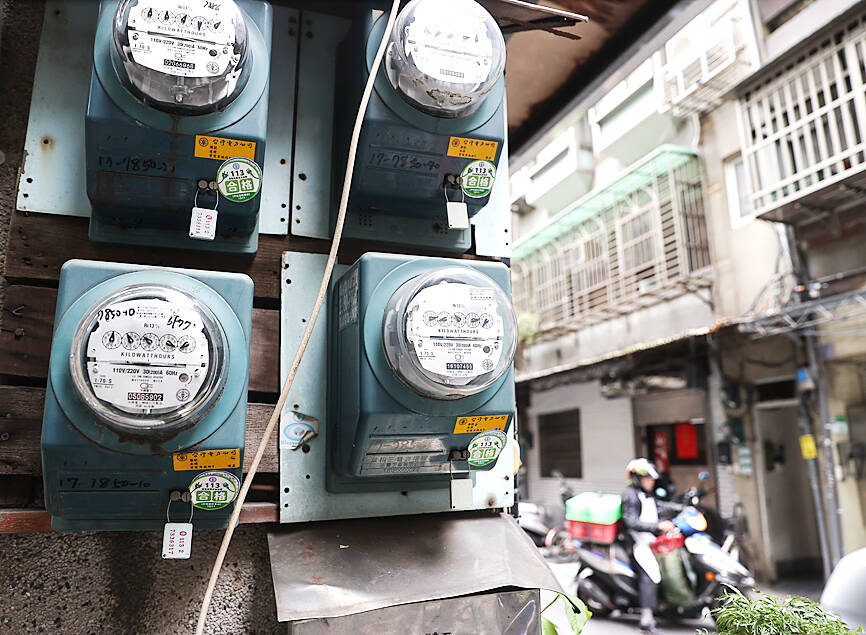The Ministry of Economic Affairs yesterday unexpectedly kept electricity rates unchanged amid concerns that global tariff hikes and geopolitical tensions have been creating economic uncertainty and price instability.
The ministry would instead continue to seek to have a NT$100 billion (US$3.02 billion) subsidy reinstalled by the legislature to help Taiwan Power Co (Taipower, 台電) stay afloat, Deputy Minister Lai Chien-hsin (賴建信) said.
“Members of the electricity price review committee did not talk much about rate adjustments, but focused their attention on the volatile international economic picture,” Lai told a media briefing that was delayed by one hour.

Photo: CNA
The decision came as a surprise, as the ministry had earlier hinted at an increase of 6 to 8 percent for different users, in line with growing international fuel costs.
US President Donald Trump on Wednesday announced a 25 percent tariff on imported vehicles starting on Thursday next week. He has also pledged to announce on Wednesday next week more extensive tariffs to address US trade imbalances with the rest of the world.
Tariff hikes would drive up production costs and inflationary pressure, while slowing the global economy, Lai said, adding that Taiwan would not emerge unaffected given its export-reliant economy.
The electricity rate freeze would cause NT$50 billion in losses for Taipower this year, he said, adding that the state-owned utility had posted cumulative losses of NT$422.9 billion in December last year.
The company has been operating at a loss to support the government’s price stabilizing efforts, he said.
Electricity price hikes have consistently fueled inflationary expectations and last year prompted the central bank to raise interest rates in March to subdue such expectations.
The monetary policymaker last week refrained from further raising interest rates on concerns that Trump’s tariff threats have already weakened consumer confidence and cast a shadow over the global economy.
The TAIEX plummeted 5.07 percent this month while the local currency depreciated against the US dollar, official data showed, as foreign portfolio managers slashed their holdings in emerging markets, including the local bourse.
Lai said it is unfair to blame Taipower for incurring losses, as the company has limited electricity price hikes to industrial and commercial users, while leaving prices for households largely unchanged to tame inflation.
That is why domestic electricity prices rose moderately relative to the steep hikes in South Korea and European countries after Russia invaded Ukraine in 2022, Taipower president Wang Yao-ting (王耀庭) said.
The ministry would ask Taipower to improve its financial standing through belt-tightening measures, while it continues to negotiate with the legislature, Lai said.
The deputy minister dismissed speculation that Taipower’s losses are related to the nation’s policy of retiring nuclear power and increasing the ratio of renewable energy sources.

Taiwan Semiconductor Manufacturing Co (TSMC, 台積電) last week recorded an increase in the number of shareholders to the highest in almost eight months, despite its share price falling 3.38 percent from the previous week, Taiwan Stock Exchange data released on Saturday showed. As of Friday, TSMC had 1.88 million shareholders, the most since the week of April 25 and an increase of 31,870 from the previous week, the data showed. The number of shareholders jumped despite a drop of NT$50 (US$1.59), or 3.38 percent, in TSMC’s share price from a week earlier to NT$1,430, as investors took profits from their earlier gains

In a high-security Shenzhen laboratory, Chinese scientists have built what Washington has spent years trying to prevent: a prototype of a machine capable of producing the cutting-edge semiconductor chips that power artificial intelligence (AI), smartphones and weapons central to Western military dominance, Reuters has learned. Completed early this year and undergoing testing, the prototype fills nearly an entire factory floor. It was built by a team of former engineers from Dutch semiconductor giant ASML who reverse-engineered the company’s extreme ultraviolet lithography (EUV) machines, according to two people with knowledge of the project. EUV machines sit at the heart of a technological Cold

Taiwan’s long-term economic competitiveness will hinge not only on national champions like Taiwan Semiconductor Manufacturing Co. (TSMC, 台積電) but also on the widespread adoption of artificial intelligence (AI) and other emerging technologies, a US-based scholar has said. At a lecture in Taipei on Tuesday, Jeffrey Ding, assistant professor of political science at the George Washington University and author of "Technology and the Rise of Great Powers," argued that historical experience shows that general-purpose technologies (GPTs) — such as electricity, computers and now AI — shape long-term economic advantages through their diffusion across the broader economy. "What really matters is not who pioneers

TAIWAN VALUE CHAIN: Foxtron is to fully own Luxgen following the transaction and it plans to launch a new electric model, the Foxtron Bria, in Taiwan next year Yulon Motor Co (裕隆汽車) yesterday said that its board of directors approved the disposal of its electric vehicle (EV) unit, Luxgen Motor Co (納智捷汽車), to Foxtron Vehicle Technologies Co (鴻華先進) for NT$787.6 million (US$24.98 million). Foxtron, a half-half joint venture between Yulon affiliate Hua-Chuang Automobile Information Technical Center Co (華創車電) and Hon Hai Precision Industry Co (鴻海精密), expects to wrap up the deal in the first quarter of next year. Foxtron would fully own Luxgen following the transaction, including five car distributing companies, outlets and all employees. The deal is subject to the approval of the Fair Trade Commission, Foxtron said. “Foxtron will be